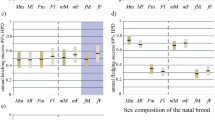Abstract
Avian sibling aggression plays an important role in controlling food distribution among nest mates. The food-amount hypothesis predicts that the amount of food obtained by siblings acts as a proximate cue controlling their level of aggression. The importance of this cue to cattle egrets (Bubulcus ibis) in Oklahoma was evaluated by studying parental feeding rates, food distribution among nestlings, and nestling aggression in three-chick broods [A-(oldest), B-, and C-chicks]. We compared nests in which siblicide occurred to nests where all three chicks survived (nonsiblicide nests). Relative to nonsiblicide nests, siblicide nests received decreasing amounts of food as the day of siblicide approached. Similarly, aggression levels of all three chicks in siblicide nests increased significantly compared with nonsiblicide nests, with most of the aggressive behavior involving B- and C-chicks. As a result, on a per-day basis, food amount and aggression exhibited a strong, negative correlation, thus providing support for the food-amount hypothesis. Though the total amount of food delivered to siblicide nests declined on the days prior to siblicide, the amount of food received by A-chicks in these nests did not. Relative to nonsiblicide nests, A-chicks in siblicide nests received an increased share (percent of volume) of the food delivered at the expense of C-chicks, with the percent remaining the same for B-chicks. The percentage of food B-chicks received the day after siblicide increased significantly from that received the day before siblicide, with no change occurring in either the amount or percentage of food received by A-chicks; clearly, B-chicks were the beneficiary of their aggressive actions that resulted in the death of C-chicks. We provide evidence supporting the hypothesis that aggression is proximately linked to food amount, possibly by a relatively simple cue such as hunger.
Similar content being viewed by others
Author information
Authors and Affiliations
Additional information
Received: 25 November 1994/Accepted after revision: 10 February 1996
Rights and permissions
About this article
Cite this article
Creighton, J., Schnell, G. Proximate control of siblicide in cattle egrets: a test of the food-amount hypothesis. Behav Ecol Sociobiol 38, 371–377 (1996). https://doi.org/10.1007/s002650050254
Issue Date:
DOI: https://doi.org/10.1007/s002650050254




